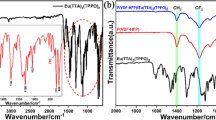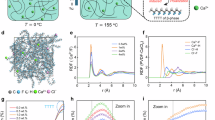Abstract
The crystal structure of polyvinylidene fluoride (PVDF) polymer could be tailored for preparing a high-performance piezoelectric sensor. Herein, the preferential orientation of the carbon nanotubes (CNTs) along the longitudinal axis of the PVDF nanofibers was achieved by adjusting the electrospinning conditions, even in the highly concentrated samples, leading to the β-phase content of more than 90%. Increasing the weight percentage of the well-oriented CNTs from 0 to 1.25, the α- to β-phase transformation entirely occurred and the output voltage increased ~ 70% from 4 to 6.8 V, respectively. At higher CNT content, the sensing performance rapidly decreased because of the sudden increase in dielectric constant and dielectric loss diagrams. The formation of the proper interfacial interactions between the uniaxially oriented CNTs and the PVDF chains, which made a perfect coaxial structure, causes an ~ 12% increase in crystallinity, ~ 100% increase in elastic modulus, and ~ 100% increase in dielectric constant. The piezoelectric sensor also showed excellent stability under a long period of 1800 cycles.
Graphical abstract







Similar content being viewed by others
Explore related subjects
Discover the latest articles and news from researchers in related subjects, suggested using machine learning.References
Han G, Su Y-F, Ma S, Tommy N, Lu N (2021) In situ rheological properties monitoring of cementitious materials through the piezoelectric-based electromechanical impedance (EMI) approach. Eng Sci 16:259–268. https://doi.org/10.30919/es8d537
Pu J, Yan X, Jiang Y, Chang C, Lin L (2010) Piezoelectric actuation of direct-write electrospun fibers. Sensors Actuators A Phys 164:131–136. https://doi.org/10.1016/j.sna.2010.09.019
Fan FR, Tang W, Wang ZL (2016) Flexible nanogenerators for energy harvesting and self-powered electronics. Adv Mater 28:4283–4305. https://doi.org/10.1002/adma.201504299
Moghadam BH, Hasanzadeh M, Simchi A (2020) Self-powered wearable piezoelectric sensors based on polymer nanofiber–metal–organic framework nanoparticle composites for arterial pulse monitoring. ACS Appl Nano Mater 3:8742–8752. https://doi.org/10.1021/acsanm.0c01551
Su Y-F, Kotian RR, Lu N (2018) Energy harvesting potential of bendable concrete using polymer based piezoelectric generator. Compos Part B Eng 153:124–129. https://doi.org/10.1016/j.compositesb.2018.07.018
Wang X, Sun F, Yin G, Wang Y, Liu B, Dong M (2018) Tactile-sensing based on flexible PVDF nanofibers via electrospinning: a review. Sensors 18:330–346. https://doi.org/10.3390/s18020330
Wu H, Cao Y, Ishige R, Higaki Y, Hoshino T, Ohta N, Takahara A (2013) Confinement-induced crystal growth in one-dimensional isotactic polystyrene nanorod arrays. ACS Macro Lett 2:414–418. https://doi.org/10.1021/mz400136d
Ramasundaram S, Rahaman A, Kim B (2019) Direct preparation of β-crystalline poly(vinylidene fluoride) nanofibers by electrospinning and the use of non-polar silver nanoparticles coated poly(vinylidene fluoride) nanofibers as electrodes for piezoelectric sensor. Polymer 183:121910–121924. https://doi.org/10.1016/j.polymer.2019.121910
Ribeiro C, Sencadas V, Ribelles JLG, Lanceros-Méndez S (2010) Influence of processing conditions on polymorphism and nanofiber morphology of electroactive poly(vinylidene fluoride) electrospun membranes. Soft Mater 8:274–287. https://doi.org/10.1080/1539445x.2010.495630
Shehata N, Elnabawy E, Abdelkader M, H. Hassanin A, Salah M, Nair R, Ahmad Bhat S (2018) Static-aligned piezoelectric poly (vinylidene fluoride) electrospun nanofibers/MWCNT composite membrane: facile method. Polymers 10:965–976. https://doi.org/10.3390/polym10090965
Persano L, Dagdeviren C, Su Y, Zhang Y, Girardo S, Pisignano D, Huang Y, Rogers JA (2013) High performance piezoelectric devices based on aligned arrays of nanofibers of poly(vinylidenefluoride-co-trifluoroethylene). Nat Commun 4:1633–1643. https://doi.org/10.1038/ncomms2639www.nature.com/naturecommunications
Sharafkhani S, Kokabi M (2020) Ultrathin-shell PVDF/CNT nanocomposite aligned hollow fibers as a sensor/actuator single element. Compos Sci Technol 200:108425–108435. https://doi.org/10.1016/j.compscitech.2020.108425
Liu ZH, Pan CT, Lin LW, Huang JC, Ou ZY (2014) Direct-write PVDF nonwoven fiber fabric energy harvesters via the hollow cylindrical near-field electrospinning process. Smart Mater Struct 23:25003–25014. http://iopscience.iop.org/0964-1726/23/2/025003
Hosseini SM, Yousefi AA (2017) Piezoelectric sensor based on electrospun PVDF-MWCNT-Cloisite 30B hybrid nanocomposites. Org Electron 50:121–129. https://doi.org/10.1016/j.orgel.2017.07.035
Liu X, Ma J, Wu X, Lin L, Wang X (2017) Polymeric nanofibers with ultrahigh piezoelectricity via self-orientation of nanocrystals. ACS Nano 11:1901–1910. https://doi.org/10.1021/acsnano.6b07961
Guo Y, Liu H, Wang D, El-Bahy ZM, Althakafy JT, Abo-Dief HM, Guo Z, Bin XuB, Liu C, Shen C (2022) Engineering hierarchical heterostructure material based on metal-organic frameworks and cotton fiber for high-efficient microwave absorber. Nano Res 15:6841–6850. https://doi.org/10.1007/s12274-022-4533-x
Pan D, Yang G, Abo-Dief HM, Dong J, Su F, Liu C, Li Y, Bin XuB, Murugadoss V, Naik N, El-Bahy SM, El-Bahy ZM, Huang M, Guo Z (2022) Vertically aligned silicon carbide nanowires/boron nitride cellulose aerogel networks enhanced thermal conductivity and electromagnetic absorbing of epoxy composites. Nano-Micro Lett 14:118–137. https://doi.org/10.1007/s40820-022-00863-z
Wu N, Zhao B, Chen X, Hou C, Huang M, Alhadhrami A, Mersal GAM, Ibrahim MM, Tian J (2022) Dielectric properties and electromagnetic simulation of molybdenum disulfide and ferric oxide-modified Ti3C2TX MXene hetero-structure for potential microwave absorption. Adv Compos Hybrid Mater 5:1548–1556. https://doi.org/10.1007/s42114-022-00490-7
Tang R, Xu P, Dong J, Gui H, Zhang T, Ding Y, Murugadoss V, Naik N, Pan D, Huang M, Guo Z (2022) Carbon foams derived from emulsion-templated porous polymeric composites for electromagnetic interference shielding. Carbon N Y 188:492–502. https://doi.org/10.1016/j.carbon.2021.12.026
He L (2021) Improve thermal conductivity of polymer composites via conductive network. ES Mater Manuf 13:1–2. https://doi.org/10.30919/esmm5f460
Sun J, Zhang X, Du Q, Murugadoss V, Wu D, Guo Z (2021) The contribution of conductive network conversion in thermal conductivity enhancement of polymer composite: a theoretical and experimental study. ES Mater Manuf 13:53–65. https://doi.org/10.30919/esmm5f450
Chen J, Zhu Y, Guo Z, Nasibulin AG (2020) Recent progress on thermo-electrical properties of conductive polymer composites and their application in temperature sensors. Eng Sci 12:13–22. https://doi.org/10.30919/es8d1129
Li G, Wang L, Lei X, Peng Z, Wan T, Maganti S, Huang M, Murugadoss V, Seok I, Jiang Q, Cui D, Alhadhrami A, Ibrahim MM, Wei H (2022) Flexible, yet robust polyaniline coated foamed polylactic acid composite electrodes for high-performance supercapacitors. Adv Compos Hybrid Mater 5:853–863. https://doi.org/10.1007/s42114-022-00501-7
Rehman S ur, Ahmed R, Ma K, Xu S, Tao T, Aslam MA, Amir M, Wang J (2021) Composite of strip-shaped ZIF-67 with polypyrrole: a conductive polymer-MOF electrode system for stable and high specific capacitance. Eng Sci 13:71–78. https://doi.org/10.30919/es8d1263
Sun D, Yan J, Ma X, Lan M, Wang Z, Cui S, Yang J (2021) Tribological investigation of self-healing composites containing metal/polymer microcapsules. ES Mater Manuf 14:59–72. https://doi.org/10.30919/esmm5f469
Su Y-F, Han G, Kong Z, Nantung T, Lu N (2020) Embeddable piezoelectric sensors for strength gain monitoring of cementitious materials: the influence of coating materials. Eng Sci 11:66–75. https://doi.org/10.30919/es8d1114
Liu Z, Zeng M, Wang H, Wang X, Yan L, Zeng C Toward flexible piezoelectrets with high environmental stability: a hybrid approach. ES Mater Manuf 17:73–82. https://doi.org/10.30919/esmm5f631
Wang H, Li Y, Wang X, Liu Z, Ahmed MF, Zeng C (2021) Preparation and characterization of piezoelectric foams based on cyclic olefin copolymer. Eng Sci 16:203–210. https://doi.org/10.30919/es8d560
Karousis N, Tagmatarchis N, Tasis D (2010) Current progress on the chemical modification of carbon nanotubes. Chem Rev 110:5366–5397. https://doi.org/10.1021/cr100018g
Lee H, Watanabe K, Kim M, Gopiraman M, Song K-H, Lee JS, Kim IS (2016) Handspinning enabled highly concentrated carbon nanotubes with controlled orientation in nanofibers. Sci Rep 6:37590–37598. https://doi.org/10.1038/srep37590
Sharafkhani S, Kokabi M (2021) High performance flexible actuator: PVDF nanofibers incorporated with axially aligned carbon nanotubes. Compos Part B Eng 222:109060–109068. https://doi.org/10.1016/j.compositesb.2021.109060
Zheng Z, Yang A, Tao J, Li J, Zhang W, Li X, Xue H (2022) Mechanical and conductive properties of Cu matrix composites reinforced by oriented carbon nanotubes with different coatings. Nanomaterials 12:266–292. https://doi.org/10.3390/nano12020266
Kyoungjin An A, Lee E-J, Guo J, Jeong S, Lee J-G, Ghaffour N (2017) Enhanced vapor transport in membrane distillation via functionalized carbon nanotubes anchored into electrospun nanofibres. Sci Rep 7:41562–41573. https://doi.org/10.1038/srep41562
He Z, Rault F, Lewandowski M, Mohsenzadeh E, Salaün F (2021) Electrospun PVDF nanofibers for piezoelectric applications: a review of the influence of electrospinning parameters on the β phase and crystallinity enhancement. Polymers 13:174–197. https://doi.org/10.3390/polym13020174
Ahn Y, Lim JY, Hong SM, Lee J, Ha J, Choi HJ, Seo Y (2013) Enhanced piezoelectric properties of electrospun poly (vinylidene fluoride)/multiwalled carbon nanotube composites due to high β-phase formation in poly (vinylidene fluoride). J Phys Chem C 117:11791–11799. https://doi.org/10.1021/jp4011026
Liu X, Xu S, Kuang X, Wang X (2016) Ultra-long MWCNTs highly oriented in electrospun PVDF/MWCNT composite nanofibers with enhanced β phase. RSC Adv 6:106690–106696. https://doi.org/10.1039/C6RA24195F
Abolhasani MM, Rezaei Abadchi M, Magniez K, Guo Q (2015) Different thermal analysis technique application in determination of fold surface-free energy. J Therm Anal Calorim 119:527–536. https://doi.org/10.1007/s10973-014-4121-8
Liu ZH, Pan CT, Lin LW, Lai HW (2013) Piezoelectric properties of PVDF/MWCNT nanofiber using near-field electrospinning. Sensors Actuators A Phys 193:13–24. https://doi.org/10.1016/j.sna.2013.01.007
Yarin AL, Koombhongse S, Reneker DH (2001) Taylor cone and jetting from liquid droplets in electrospinning of nanofibers. J Appl Phys 90:4836–4846. https://doi.org/10.1063/1.1408260
Ke K, Pötschke P, Jehnichen D, Fischer D, Voit B (2014) Achieving β-phase poly (vinylidene fluoride) from melt cooling: effect of surface functionalized carbon nanotubes. Polymer 55:611–619. https://doi.org/10.1016/j.polymer.2013.12.014
Issa AA, Al-Maadeed MA, Luyt AS, Ponnamma D, Hassan MK (2017) Physico-mechanical, dielectric, and piezoelectric properties of PVDF electrospun mats containing silver nanoparticles. C 3:3040030–3040046. https://doi.org/10.3390/c3040030
Hosseini H, Kokabi M, Mousavi SM (2019) Conductive network formation in bacterial cellulose-based nanocomposite aerogels. Compos Part B Eng 174:106981–106989. https://doi.org/10.1016/j.compositesb.2019.106981
Wang P, Song T, Abo-Dief HM, Song J, Alanazi AK, Fan B, Huang M, Lin Z, Altalhi AA, Gao S, Yang L, Liu J, Feng S, Cao T (2022) Effect of carbon nanotubes on the interface evolution and dielectric properties of polylactic acid/ethylene–vinyl acetate copolymer nanocomposites. Adv Compos Hybrid Mater 5:1100–1110. https://doi.org/10.1007/s42114-022-00489-0
Sharafkhani S, Kokabi M (2022) Modeling the dielectric behavior of polymer nanocomposites considering interphase properties and nanoparticle geometry. Polym Bull. https://doi.org/10.1007/s00289-022-04364-2
Yuan J-K, Li W-L, Yao S-H, Lin Y-Q, Sylvestre A, Bai J (2011) High dielectric permittivity and low percolation threshold in polymer composites based on SiC-carbon nanotubes micro/nano hybrid. Appl Phys Lett 98:32901–32904. https://doi.org/10.1063/1.3544942
Silakaew K, Thongbai P (2019) Significantly improved dielectric properties of multiwall carbon nanotube-BaTiO3/PVDF polymer composites by tuning the particle size of the ceramic filler. RSC Adv 9:23498–23507. https://doi.org/10.1039/C9RA04933A
Francis E, Ko HU, Kim JW, Kim HC, Kalarikkal N, Varughese K, Kim J, Thomas S (2018) High-k dielectric percolative nanocomposites based on multiwalled carbon nanotubes and polyvinyl chloride. J Mater Chem C 6:8152–8159. https://doi.org/10.1039/C8TC02528B
Li K, Hou D, Fu C, Wang K, Wang J (2019) Fabrication of PVDF nanofibrous hydrophobic composite membranes reinforced with fabric substrates via electrospinning for membrane distillation desalination. J Environ Sci 75:277–288. https://doi.org/10.1016/j.jes.2018.04.002
Baji A, Mai Y-W, Abtahi M, Wong S-C, Liu Y, Li Q (2013) Microstructure development in electrospun carbon nanotube reinforced polyvinylidene fluoride fibers and its influence on tensile strength and dielectric permittivity. Compos Sci Technol 88:1–8. https://doi.org/10.1016/j.compscitech.2013.08.021
Bower AF (2009) Applied mechanics of solids. CRC Press, USA
Garcia C, Trendafilova I, Sanchez del Rio J (2019) Detection and measurement of impacts in composite structures using a self-powered triboelectric sensor. Nano Energy 56:443–453. https://doi.org/10.1016/j.nanoen.2018.11.055
Arnau A, Soares D (2009) Fundamentals of piezoelectricity. In: Vives A.A (ed.) Piezoelectric transducers and applications. Springer-Verlag, Berlin Heidelberg, pp 1–38. https://doi.org/10.1007/978-3-540-77508-9_1
Sun Y, Chen J, Li X, Lu Y, Zhang S, Cheng Z (2019) Flexible piezoelectric energy harvester/sensor with high voltage output over wide temperature range. Nano Energy 61:337–345. https://doi.org/10.1016/j.nanoen.2019.04.055
Kim HJ, Kim YJ (2018) High performance flexible piezoelectric pressure sensor based on CNTs-doped 0–3 ceramic-epoxy nanocomposites. Mater Des 151:133–140. https://doi.org/10.1016/j.matdes.2018.04.048
Acknowledgements
The authors wish to thank Tarbiat Modares University and the Iran Nanotechnology Initiative Council (INIC) for their support.
Author information
Authors and Affiliations
Corresponding author
Ethics declarations
Conflict of interest
The authors declare no competing interests.
Additional information
Publisher's Note
Springer Nature remains neutral with regard to jurisdictional claims in published maps and institutional affiliations.
Supplementary Information
Below is the link to the electronic supplementary material.
Rights and permissions
Springer Nature or its licensor holds exclusive rights to this article under a publishing agreement with the author(s) or other rightsholder(s); author self-archiving of the accepted manuscript version of this article is solely governed by the terms of such publishing agreement and applicable law.
About this article
Cite this article
Sharafkhani, S., Kokabi, M. Enhanced sensing performance of polyvinylidene fluoride nanofibers containing preferred oriented carbon nanotubes. Adv Compos Hybrid Mater 5, 3081–3093 (2022). https://doi.org/10.1007/s42114-022-00565-5
Received:
Revised:
Accepted:
Published:
Issue Date:
DOI: https://doi.org/10.1007/s42114-022-00565-5




